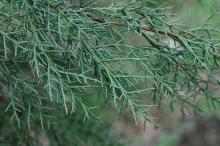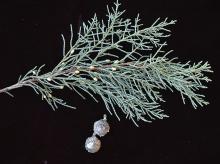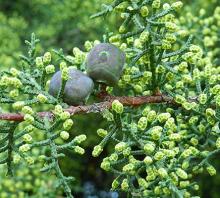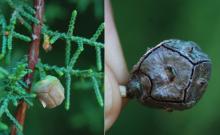Hesperocyparis bakeri
Common name:
Baker Cypress
Modoc Cypress
Siskiyou Cypress
Pronunciation:
HES-per-oh-SIP-air-iss BAKE-er-i
Family:
Cupressaceae
Genus:
Synonyms:
Callitropsis bakeri
Cupressus bakeri
Type:
Conifer
Native to (or naturalized in) Oregon:
Yes
- Evergreen conifer, small tree, usually less than 50 ft (15 m) but record trees reach over 70 ft (21 m), slow growing, open, spreading branches, aromatic twigs. Bark on the main trunk is reddish-brown, smoothish, often peeling in curling plates. Mature scale-like leaves are flat, closely appressed, short, 2 mm long, pointed, noticeable resin gland, in opposite, alternating pairs, forming 4 rows, gray-green. Seed cones are gray or dull brown, squarish to nearly spherical, about 2 cm across, commonly with 6 scales. They often remain closed for several years, only opening after the parent tree is killed in a wildfie, thereby allowing the seeds to colonize the bare ground exposed by the natural fire. Male (pollen) cones develop in summer but don't release their pollen until spring.
- Note: The scale-like leaves are in opposite, alternating pairs (decussate) and their associated bud have the same arrangement, hence branchlets derived from these buds are arranged similarly, resulting in four vertical rows. In contrast, Western Juniper, Juniperus occidentalis, has scale-like leaves that are usually in whorls of three, thus its branchlets are vertically arranged in rows of three rather than four (see comparison)
- Taxonomy: There has been a good deal of taxonomic discussion in recent years regarding some of the species in the Cupressaceae. This has resulted in Baker/Modoc Cypress being classified as Cupressus bakeri, Callitropsis bakeri, and more recently as Hesperocyparis bakeri. As of 2024, Hesperocyparis (western cypress), (hesperus, -a, -um; Latin, of the west, western) is listed as the correct classification of this species by Plants of the World Online, World Flora Online, and the Gymnosperm Database. There is disagreement about this classification, with some scientists continuing to use Cupressus in preference to Hesperocyparis. For details, click on the Genus Hesperocyparis above.
- Sun. Needs well-drained soil.
- Hardy to USDA Zone 5 The most northern and hardiest cypress in North America. Native to southwestern Oregon (Jackson and Josephine counties) and northern California, mostly at elevation between 3,500 and 7,000 ft (1,060-2,100 m).
- bakeri: after Milo Samuel Baker (1868-1961), California botanist who discovered the species in 1898.
- Oregon State Univ., Peavy Arboretum and south of Peavy Hall (2011)
- Portland, Oregon: Hoyt Arboretum
Click image to enlarge












